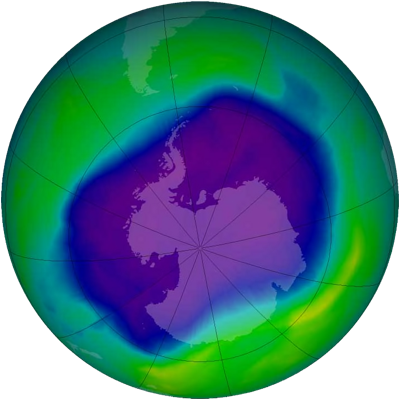Welcome to NASA's Ozone Mapping and Profiler Suite (OMPS) core and science teams.
The OMPS series of instruments comprise the next generation of back-scattered UltraViolet (BUV) radiation sensors. This web site is the location of all information pertaining to their efforts concerning these instruments:
- The core team is responsible for assessing the performance, and maintaining the calibration, of the OMPS sensors and providing L1B products for use by the science team and the outside community. They also help the science team in assessing the performance of L2 products.
- The science team is responsible for generating L2 products consistent with NASA's goals of maintaining and expanding long term climate records as well as developing new and novel products from OMPS measurements. They also help the core team in assessing sensor calibration and performance.
The first OMPS was launched onboard the Suomi NPP satellite in October 2011 and continues to provide well calibrated measurements from two nadir sensors (one focused on total column ozone retrieval and one focused on ozone profile retrieval) and a sensor looking at the atmospheric limb (focused on providing ozone profile retrievals with higher vertical resolution than is possible from the nadir direction). The core teams's L1B products for these sensors as well as the science team's L2 products generated from the L1B products can be found at the GSFC DISC:
https://disc.gsfc.nasa.gov/datasets?page=1&source=SUOMI-NPP%20OMPS
In addition, OMPS L2 near real time products for ozone, SO2, and aerosol index are now part of NASA's LANCE system:
https://earthdata.nasa.gov/earth-observation-data/near-real-time
and near real-time imagery using those products is available via:
| Map Viewer | Worldview |
Finally, real-time OMPS L2 ozone, SO2, and aerosol index data are available via the IPOPP software developed and maintained by GSFC's Direct Readout Lab (DRL):
https://directreadout.sci.gsfc.nasa.gov
A second OMPS recently launched on 18 November 2017 onboard the NOAA-20 satellite. This version of OMPS only contains the two nadir sensors. Preliminary L1Bs from these sensors should be available in 2018, with L2 products availaible somewhat later.
To help the core and science team, members of the OMPS Science Investigator-led Processing System (SIPS) provide coding and processing support and assistance. We'd like acknowledge and thank their efforts here.
Papers published by the core and science teams:
Jaross, G., P. K. Bhartia, G. Chen, M. Kowitt, M. Haken, Z. Chen, P. Xu, J. Warner, and T. Kelly (2014), OMPS Limb Profiler instrument performance assessment, J. Geophys. Res. Atmos., 119, 4399–4412, doi:10.1002/2013JD020482.
Seftor, C.J., G. Jaross, M. Kowitt, M. Haken, J. Li, L.E. Flynn (2014), Post-Launch Performance of the Suomi NPP Ozone Mapping and Profiler Suite (OMPS) Nadir Sensors, J. Geophys. Res., doi: 10.1002/2013JD020472.
Kramarova, N., E. Nash, P. Newman, P. K. Bhartia, R. McPeters, D. Rault, C. Seftor, P. Q. Xu, and G. Labow (2013), Measuring the Antarctic ozone hole with the new Ozone Mapping and Profiler Suite (OMPS), Atmos. Chem. Phys., 14, 2353-2361, doi:10.5194/acp-14-2353-2014, 2014.
Vasilkov, A., Joiner, J., and Seftor, C., First results from a rotational Raman scattering cloud algorithm applied to the Suomi National Polar-orbiting Partnership (NPP) Ozone Mapping and Profiler Suite (OMPS) Nadir Mapper, Atmos. Meas. Tech., 7, 2897-2906, doi:10.5194/amt-7-2897-2014, 2014.
Yang, K., R. R. Dickerson, S. A. Carn, C. Ge, and J. Wang (2013), First observations of SO2 from the satellite Suomi NPP OMPS: Widespread air pollution events over China, Geophys. Res. Lett., 40, 4957–4962, doi:10.1002/grl.50952.
Yang, K., S. A. Carn, C. Ge, J. Wang, and R. R. Dickerson (2014), Advancing measurements of tropospheric NO2 from space: New algorithm and first global results from OMPS, Geophys. Res. Lett., 41, 4777–4786, doi:10.1002/2014GL060136.
Gonzalo González Abad, Alexander Vasilkov, Colin Seftor, Xiong Liu, and Kelly Chance Atmos. Meas. Tech., 9, 2797-2812, doi:10.5194/amt-9-2797-2016, 2016
